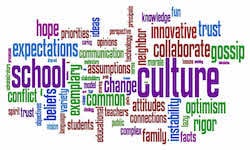Table of Contents
Using 6 technology ideas to increase rigor and enhance a variety of learning Rigor is a hot topic in education, and increasing rigor is important so that students can reach their potential. We also regularly use technology in our instruction. How can we merge the two? Let’s look at 6 technology-based ideas that can increase the rigor in your classroom.
- Mystery Skypes
- Analysis and Justification Through Wikipedia
- Collaborating with Wikis
- Creating Apps
- Maps and Locations
- Timelines
Mystery Skypes
Mystery Skypes are used by many educators to incorporate inquiry and collaborative learning in the classroom. In a Mystery Skype, a classroom connects with another classroom in another location. You can find classrooms through Skype (education.skype.com/mysteryskype) or you can tweet out a request.
Once you are connected, you set a time to Skype with the other classroom. Each group of students asks questions of the other class to try to determine their location. Assigning roles to different students can facilitate the process.
Sample Roles
- Greeter
- Question Asker
- Runner
- Google mapper
- Globe person
- Atlas person
From:
Many educators suggest having students ask only yes/no questions. My concern with that approach is that it isn’t rigorous for those asking or answering the questions. Some yes/no questions are appropriate, but I would encourage students to prepare (in advance) questions that are also at higher levels.
Sample Questions
- What is a difference between where you live and somewhere else in your state or country?
- Why do you like where you live?
- What might be the first thing a visitor would notice about where you live?
- What is unique about where you live?
 Even though those are also “what” questions, notice that they require thinking. Once students have correctly guessed the location of the partner classroom, do additional research, focusing on making connections to each student’s life. Then, ask students to create a web showing the connections they have with the other location. For example, you may have a student who has visited the partner location, or one who saw a kangaroo in a whale (which connects to the classroom in Australia). Share with the partner classroom and have those students add to the web.
Even though those are also “what” questions, notice that they require thinking. Once students have correctly guessed the location of the partner classroom, do additional research, focusing on making connections to each student’s life. Then, ask students to create a web showing the connections they have with the other location. For example, you may have a student who has visited the partner location, or one who saw a kangaroo in a whale (which connects to the classroom in Australia). Share with the partner classroom and have those students add to the web.
There is a second way to do Mystery Skypes. Let’s say you have planned a Skype with an author. For each of several days prior to Skype, provide clues about the guest. Students place their guess as to who the guest is, along with their reason for their guess (their justification) in a mailbox. The day before the Skype, graph all the guesses on a chart and agree on a “best guess.” During the discussion after the Skype, analyze their conclusions.
Analysis and Justification through Wikipedia
We will address the use of Wikis in the next section, but I want to discuss a particular challenge for many teachers: the overuse of Wikipedia as a source of information. Countless teachers have complained to me that their students view Wikipedia as the first and only place to learn. Although there are strategies to encourage students to use other sources, I’d like to give you one specific activity that encourages higher order thinking with Wikipedia.
Students are given (or they choose) a topic. Their job is to be a fact-checker. They must research the topic using other sources to confirm the information in the Wikipedia entry. For each point made in the entry, students must identify two additional sources that support the point. With this process, they are justifying the information, using evidence from other sources. Additionally, they may find an error, and if so, they can report the mistake with their evidence.
Collaborating with Wikis
Wikis are websites that allow for collaborative creation and editing. They are particularly useful when asking a group of students to work together to create content to demonstrate learning. Remember to craft assignments that are rigorous, rather than students simply stating facts or summarizing. Sample wikis for the classroom include a fan room of favorite scientists, online debates, pioneers to the West (with blog entries), or creating fan fiction using characters from a story or novel. They are only limited by your and your students’ imaginations. In addition to students creating the content on the Wiki, you might also consider assigning roles to students in a group. William M. Ferriter and Adam Garry (2010), in their book Teaching the iGeneration, provide suggestions.
Sample Roles Related to Wikis
- Link Layer
- Flowmaster
- Spelling Cop
- Discussion Starter
- Captain Spit-and-Polish
Creating Apps
Vicki Davis, known as CoolCatTeacher, shared with me that an excellent way for students to work at higher levels with technology is to create their own apps. Using the app CRESCERANCE her students have invented apps for a variety of purposes, such as money management. Vicki learned about CRESCERANCE from a fifth-grader who developed an app to teach Spanish. Of course, as with any product, there can be low level or rigorous examples. It’s important to help students design apps that are rigorous. Apps that simply require data entry and tracking or memorization and review are not rigorous.
Rigorous Apps
- Encourage users to make connections
- Require higher order thinking skills
- Ask for reflection and justification (such as “why was your workout shorter today”)
Maps and Locations
 Vicki also uses maps with her students in a different ways. Students can take Google Maps and identify points on a map, such as Napoleon’s March. They can also create their own maps with 360 degree cameras. For example, if you are teaching the Civil War, and your school is located near a historic battlefield, students can visit the landmark, take their own videos and either embed the views in google maps, or they can identify and video what they consider to be the most important part of the battle. As a part of the final product, students justify why their location is most important, and provide appropriate links to other resources that support their position. As Vicki points out, creating maps not only requires students to show an understanding of content and technology, it “uses computation and sequential thinking which pushes you higher.”
Vicki also uses maps with her students in a different ways. Students can take Google Maps and identify points on a map, such as Napoleon’s March. They can also create their own maps with 360 degree cameras. For example, if you are teaching the Civil War, and your school is located near a historic battlefield, students can visit the landmark, take their own videos and either embed the views in google maps, or they can identify and video what they consider to be the most important part of the battle. As a part of the final product, students justify why their location is most important, and provide appropriate links to other resources that support their position. As Vicki points out, creating maps not only requires students to show an understanding of content and technology, it “uses computation and sequential thinking which pushes you higher.”
Timelines
Another great idea Vicki told me about was creating timelines about the history of computing. You could use this with any type of timeline. Notice that although the project starts off at a basic level, but quickly moves into more rigorous work. First, students individually create timelines using information from their text and online sources. They put the 10 most important events on their timeline and defend their choices. After all students have finished, the class compares the timelines, debates the choices, and come to consensus on the 10 most important overall events.
What I would add to increase the rigor even more is to have students choose one of their individual events that did not make the final timeline. If all of their choices are on the group timeline, they should identify one from a classmate’s timeline. Using that event, write about how life would change if that event never happened, providing evidence to support the perspective. Prepare a vlog with the information.
A Final Note
Technology is a wonderful tool to enhance our instruction. However, when we plan intentionally, we can use it to increase rigor, and learning, in our classroom.
Further Reading
- edCircuit – Barbara Blackburn Columns
- Edutopia – A New Definition of Rigor
- TeachThought – How To Add Rigor To Anything

